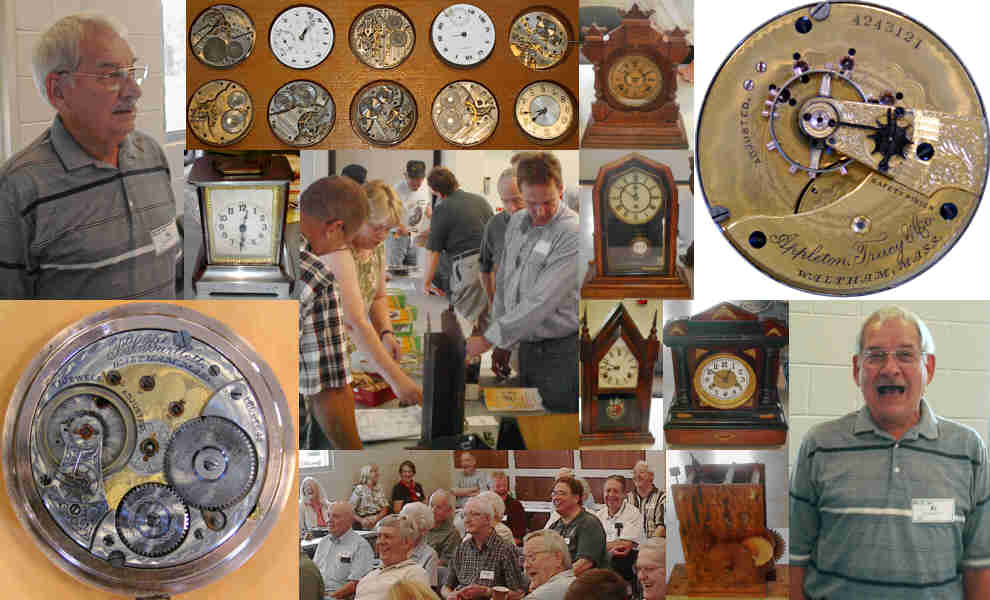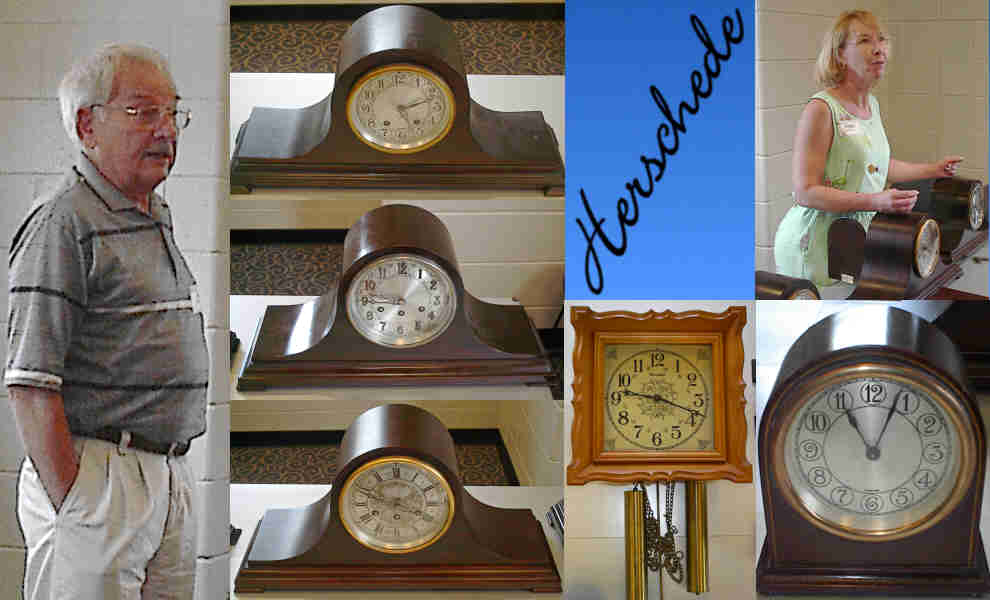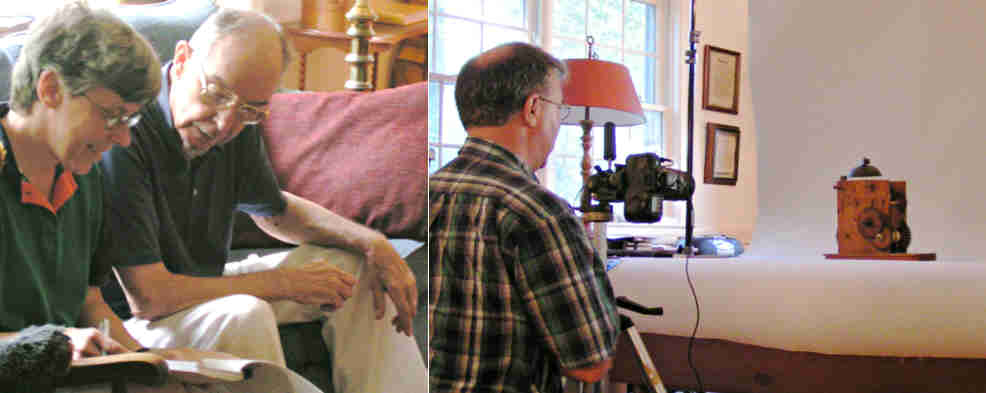
Chapter 24's August 1, 2004, meeting began as always with the refreshments being set up as soon as the doors opened. The decaf coffee was ready shortly thereafter, but those needing the more eye-opening brew had to wait a bit longer. Nevertheless, the tables were loaded with goodies, most of which were rapidly consumed as the socializing hit its stride.
Those looking for a bargain weren't disappointed as our eminent auctioneer, Brooks Coleman, launched into the task, quickly disposing of the lots. Brooks made it fun, scoring fairly high on the laugh-o-meter.
The topic of the Watch Focus Group was Waltham's model 1883 movements. A large number appeared for display including a number of gilt damaskeened Appleton, Tracy & Co. grade and frosted grade No. 35 movements. Pictures were displayed of such well-known private labeled examples as the "Santa Fe" route watches that Henry Montgomery had made for use on the Atchison, Topeka and Santa Fe Railway. There were reproductions of 1880s ads noting the factory descriptions of a number of model `83 grades. These were free for the taking (the ads, not the watches) and disappeared quickly.

Al Grosskreutz presented the program, "The Rise and Fall of the Herschede Hall Clock Company." Al took us through the history of the almost-century-old company known as the Herschede Hall Clock Co. Frank Herschede was born in Cincinnati, Ohio on July 20, 1857. At age 16, he apprenticed as a watch and clock repairman and after only four years he decided to open his own store. By 1885, his business grew and he had to move it to larger quarters. He started importing Elliot movements for his tall case clocks.
"Herschede," a name synonymous with quality, won many awards starting in 1901 with a gold medal at the South Carolina and West Indian Exhibition. Several more medals were won in the Louisiana Purchase Exposition in 1904. Herschede became a family business when Frankís son, Walter, joined the company. By 1909 Herschede set up to manufacture their own movements, rather than importing, and on January 12, 1911, the first Herschede movement was assembled and passed final inspection. They were named Crown, thus the Crown trademark. Charles Eisen composed the Canterbury Chime melody and gave it to Frank Herschede as a gift. This melody is a Herschede exclusive. In 1915, the quality of the Herschede line resulted in the Grand Prize award for chime hall clocks and mantel clocks, and a gold medal for hall clock cabinets. These clocks were now sought after worldwide.
The company continued to grow and flourish through the 1920ís. By 1929, they employed about 300 workers and that year had sales of $1.2 million. Then the stock market crashed and, along with other economic factors, in 1933, sales dropped to only $187,000. WWII halted production for anything other than government contracts. After the war the company was unionized and a twenty-percent excise tax was imposed on luxury items, which included clocks. The Korean War again brought production focus to military needs. In the 1950ís, stiff competition came from less expensive European made clocks and Herschede began importing clock movements and complete clocks sold under the Herschede name. Labor, taxes and other expenses caused the company to move from Cincinnati, Ohio to Starkville, Mississippi, in 1960.
Later, the company was acquired by businessman, John Arnold. On September 23, 1983, Herschede implemented a plan to restructure the Herschede Hall Clock division from a manufacturer of finished clocks to a supplier of quality tubular movements to the industry. On August 21, 1984, a letter was written by Richard L. Herschede, Jr. to certify that the last three clocks shipped from Herschede factory in Mississippi were sent to Champís Clocks in Douglasville, Georgia. Richard Herschede visited Champís on July 28, 1984, to personally sign these three clocks. You can see one of these clocks at Champís, and it could be yours for $100,000. After 99-1/2 years, the Herschede Hall Clock Company no longer existed. At the meeting, we had several examples of Herschedeís quality shelf clocks from the 1920ís and one wall clock with a German movement from the 1950ís on display. Al told us of a clock he found, an exquisite wall clock from the early 1900ís with all three melodies, but he could only bring pictures, since a customer of his just had to have it.

Members brought four Herschede clocks for exhibition, three tambours, and one late model wall clock with a German movement. One of the Herschede's had the "Canterbury Chime" which was developed for Herschede.
On a personal note, Ward Francillon asked if anyone would volunteer to help with a project of photographing his clock collection. They are being professionally photographed for a book in progress. Each clock needs to be moved to the photographing area and Ward would need help with moving them. Several of our members jumped at the chance to not only see the collection, but touch it too. Of course, they promised not to drool. (See the photos below of Ward and Anne Camp, and the photo session in progress.)
